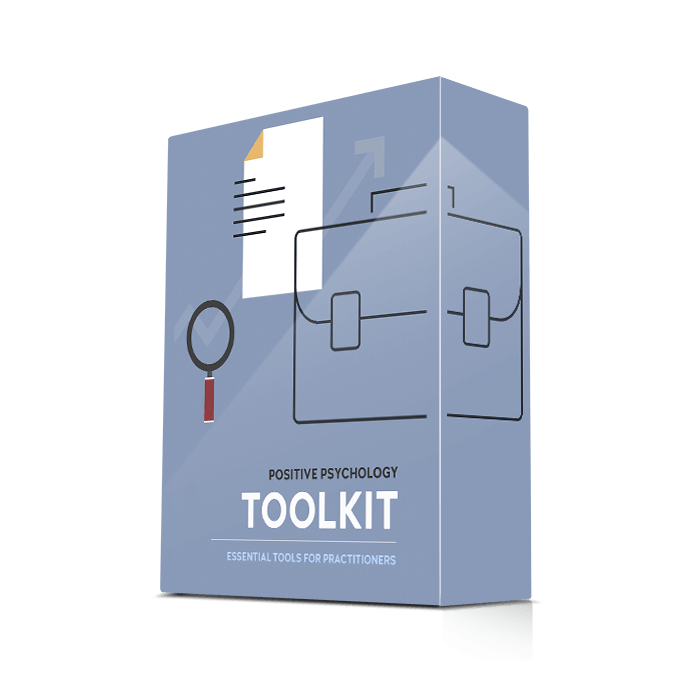

Innovation. Growth. Security. Success.
These are the outcomes of working as a team, whether in business or on the sports field. Yet teamwork comes with its own set of challenges.
Would you like to know how to leverage the many benefits of teamwork?
Yet avoid its pitfalls, such as lack of communication, poor trust, and personality clashes among team members?
Then this article is for you, as we explore the psychology of teamwork and share actionable habits that can build highly effective teams.
Before you continue, we thought you might like to download our three Work & Career Coaching Exercises for free. These detailed, science-based exercises will help you or your clients identify opportunities for professional growth and create a more meaningful career.
Psychological theory, research, and models provide valuable insights and guidance into effective team building and maintenance in various workplace settings, including schools, hospitals, corporate offices, oil rigs, power plants, and the military (Salas et al., 2018).
Psychology has come a long way in understanding such complex groups—as recognized by a special issue on the “Science of Teamwork” in the American Psychological Association’s flagship journal American Psychologist in 2018.
Teams are vital and commonplace. Because of their prevalence and impact, “our safety, security, comfort, and innovation depend on good teamwork and collaboration” (Salas et al., 2018, p. 593).
Innovation is often the result of constant communication and side-by-side work and takes place “when collaboration translates each person’s creativity into group genius” and conflict is avoided (Sawyer, 2007, p. 13).
But then, what are teams exactly, and how do we define them?
We must begin by understanding what defines a “group.” Within an organization, a group is more than simply a collection of people. Members recognize themselves as a social entity that (Davenport, 2009):
And yet, teams go further. They share a common goal. With the modern workplace demanding successful partnering across functional and geographical divides, fostering collaborative team working cultures becomes increasingly vital (Davenport, 2009).
Therefore, an effective team has the following attributes (Davenport, 2009):
The points above are helpful because they enable us to distinguish between people working together in groups and those forming effective teams.
When considered together, it’s possible to arrive at the following teamwork definition: “Teamwork can be defined as the ability of team members to work together, communicate effectively, anticipate and meet each other’s demands, and inspire confidence, resulting in a coordinated collective action” (Salas & Cannon-Bowers, 2001, extract).
And a definition of team building might arise as follows:
“Team building is an ongoing process that helps a work group evolve into a cohesive unit. The team members not only share expectations for accomplishing group tasks, but trust and support one another and respect one another’s individual differences” (Team building: Introduction, n.d., para. 1).
“We know what effective teams do, think, and feel. We know what influences team dynamics, and some interventions that help develop teamwork” (Salas et al., 2018, p. 593).
Psychological research has confirmed that the following elements are the minimum prerequisites for an effective team:
Several psychological and organizational models and frameworks have grown out of the need to understand and explain how teams form, grow, develop, maintain, and change in the workplace.
The following three early models are valuable for our current understanding of how effective teams evolve (Davenport, 2009).
Bass and Ryterband’s (1979) model of team development includes four stages and areas of focus:
Woodcock’s (1979) model of team development also has four stages:
Tuckman’s (1965) model of team development includes five stages:
As with individuals, team performance in sports can benefit from time spent building psychological capital, which comprises four key elements (Luthans et al., 2015):
Furthermore, according to positive psychology consultant and performance coach John Yeager, sports teams collectively benefit from coaching focused on each element to build the psychological capital required to boost their combined performance.
Once achieved, they “maintain a healthy culture and find an effective balance between holding athletes accountable and supporting each other” (Yeager, 2021, p. 223).

Managers can sometimes view team collaboration as a “black box,” only considering individual team members’ characteristics without looking inside the process itself (Sawyer, 2007).
Keith Sawyer (2007, p. 13), a psychologist at Washington University, says that his research shows “the secret to understanding what makes a collaboration successful lies inside the box, in moment-to-moment interactional dynamics.”
This understanding led him to rethink group innovation and creativity, identifying the following seven key characteristics (or habits) of effective, creative teams along with suggested actions for moving innovation forward (Sawyer, 2007):
ACTION: Encourage team members to take time each day/week to brainstorm and share new ideas and establish a structure for combining and building on those ideas over time.
ACTION: Prioritize active listening and observation during team meetings and discussions. And provide opportunities for team members to practice deep listening skills.
ACTION: Recognize the potential of other team members’ ideas and accept the importance of collective ownership to drive forward problem-solving.
ACTION: Emphasize the importance of evolving and adapting ideas as a team, rather than attributing them to one individual.
ACTION: Encourage team members to question assumptions and think outside the box by regularly posing surprising or unconventional questions during meetings and discussions.
ACTION: Recognize that innovation can be inefficient and messy but emphasize the potential for breakthroughs.
ACTION: Foster a bottom-up approach to innovation, starting with small details and building toward the bigger picture.
While all seven are characteristics of an effective team, they are also actionable tasks within the process where team members play off each other (Sawyer, 2007).

These 17 Work & Career Coaching Exercises [PDF] contain everything you need to help others find more meaning and satisfaction in their work.
Created by Experts. 100% Science-based.
The following are two high-profile examples of the immense potential of effective teamwork, especially when the stakes are high (Keup, 2022; Allen, 2022).
The Apollo 11 mission in 1969 is a prime example of teamwork at its finest.
While the world celebrated the achievement of Neil Armstrong, Buzz Aldrin, and Michael Collins, the success of the mission resulted from the efforts of a much larger team.
The mission planners, scientists, engineers, and technicians, numbering around 400,000, worked tirelessly for years to make the moon landing a reality. The team’s cohesion was strengthened by the astronauts’ close collaboration with these groups, emphasizing the importance of human connection in any team.

The Positive Psychology Toolkit© is a groundbreaking practitioner resource containing over 500 science-based exercises, activities, interventions, questionnaires, and assessments created by experts using the latest positive psychology research.
Updated monthly. 100% Science-based.
“The best positive psychology resource out there!”
— Emiliya Zhivotovskaya, Flourishing Center CEO
Wikipedia is the epitome of teamwork in the digital age. It’s a collaborative engine of knowledge that is constantly evolving, thanks to the efforts of an army of volunteer writers and editors.
Unlike traditional encyclopedias, Wikipedia is constantly updated and open to debate and challenge, making it a dynamic and accurate source of information.
While the scale of this teamwork is almost incomprehensible, the site runs smoothly, with errors quickly discovered and corrected. Everyone who has landed on the site is considered a part of the team, making Wikipedia a perfect example of how teamwork can achieve great things in the digital age.
Understanding what stops or limits individual and group performance can help us build and maintain motivated, resilient, and highly effective teams.
The following 10 barriers can present themselves in real-world team environments (Haas & Mortensen, 2016):

The following is a list of 10 vital skills for building high-performing and successful teams; they prioritize cohesion, good communication, and are goal focused (Haas & Mortensen, 2016; Steps to building an effective team, n.d.; Boogaard, 2022):
We have many practical resources for you as a manager or leader supporting your team as they form, develop, and attempt to avoid some challenges of group dynamics.
Our free resources include the following:
Our Emotional Intelligence Masterclass© helps boost teamwork by teaching staff to handle emotions better. The training improves communication, relationships, decision-making, job satisfaction, motivation, and overall wellbeing. It also enhances the emotional intelligence of the coach, making them better equipped to lead teams.
The Positive Relationships Masterclass© strengthens teamwork using the “Six Pillars of Positive Relationships.” It offers practical techniques to enhance communication and maintain healthy relationships, leading to improved coaching skills and a thriving workplace.
You will learn the key aspects of positive relationships and explore science-based ways to categorize the different types of positive network members and grow social capital.
Not only that, but we also have specific articles that delve into team-building topics; for example:
And lastly, if you’re looking for more science-based ways to help your team develop their strengths, check out this collection of 17 strength-finding tools. Use them to help others better understand and harness their strengths in life-enhancing ways.
Research in the psychology of teamwork has shown that effective collaboration can lead to improved productivity, creativity, and job satisfaction among team members (Sawyer, 2007; Salas et al., 2018).
When teams experience a sense of belonging and purpose in their work, they are more likely to achieve their goals and be motivated to perform at their best. It can also lead to improved organizational outcomes, such as achieving goals, making better decisions, and providing higher levels of customer service.
Great teamwork relies on successful team building—the process of creating a cohesive, high-performing team capable of working together successfully. Effective team building can reduce conflicts, turnover, and absenteeism among its members by fostering a positive culture and improving overall morale.
As a manager, you can encourage the best out of your teams by creating a supportive and inclusive environment, encouraging clear communication, and promoting trust, accountability, and active listening.
Additionally, you can provide training and resources to help team members develop the skills they need to work well together, such as problem-solving, conflict resolution, and emotional intelligence. In our resources section, we provide a recommended selection of free and paid resources—all well worth it to build your own highly effective team.
We hope you enjoyed reading this article. Don’t forget to download our three Work & Career Coaching Exercises for free.
References